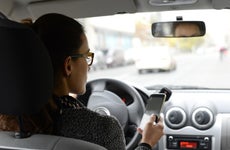Drowsy driving statistics and facts 2024

The Bankrate promise
At Bankrate, we strive to help you make smarter financial decisions. To help readers understand how insurance affects their finances, we have licensed insurance professionals on staff who have spent a combined 47 years in the auto, home and life insurance industries. While we adhere to strict , this post may contain references to products from our partners. Here's an explanation of . Our content is backed by Coverage.com, LLC, a licensed entity (NPN: 19966249). For more information, please see our .
Each year, drowsy driving accounts for about 328,000 crashes, 109,000 injuries and about 6,400 fatalities per year, according to the latest study from the AAA Foundation for Traffic Safety. Speeding, drinking and driving and distracted driving are well-known contributors to car crashes and traffic-related fatalities, but until recently, drowsy driving has flown under the radar. Drowsy and tired driving is dangerous because many people are unaware of how tired they are until they are behind the wheel of a car, potentially putting themselves and others at risk. Bankrate’s editorial team breaks down the latest drowsy driving statistics and offers some tips on being a safer and more alert driver.
Drowsy driving statistics
- Statistics show an estimated 17.6 percent of fatal car crashes between 2017 and 2021 involved a drowsy driver (AAA Foundation)
- The majority of drowsy-driving crashes happen between midnight and 6 a.m. or in the late afternoon hours. (NHTSA)
- 1 in 25 drivers admit to falling asleep behind the wheel. (CDC)
- Driving drowsy and driving drunk have similar effects. Driving after more than 20 hours without sleep is estimated to be the equivalent of driving with a BAC of 0.08 percent. (NSC)
- Data shows that you are three times more likely to be in a car accident if you are fatigued. (NSC)
- Fatigue-related crashes resulting in injuries or fatalities cost more than $109 billion annually, which does not include the cost of property damage. (AAA)
- Drowsy driving accounts for about 328,000 crashes annually on the roadway, 109,000 injuries and 6,400 fatalities each year. (AAA Foundation)
- An estimated 96 percent of drivers say that drowsy driving is very or extremely dangerous. However, less than 30 percent of drivers think drowsy drivers are at risk of getting pulled over by law enforcement. (AAA Foundation)
- About 24 percent of drivers have admitted to driving while being so fatigued that they struggled to keep their eyes open at least once in the past 30 days. (AAA Foundation)
- In 2021, more than 1.310 drivers who were involved in fatal crashes reported being drowsy, which accounted for about 2.2 percent of all fatal accidents. (Triple-I)
What is drowsy driving?
Drowsy driving, also known as driver fatigue or tired driving, is the act of driving or operating a motor vehicle while tired and feeling fatigued or sleepy. Job stress or interrupted nights with young children are common reasons for being short on sleep.
However, other factors can contribute to drowsy driving, such as a medication you are taking or an untreated sleep disorder that leaves you depleted and unable to stay awake during the day. Late-night and third-shift workers are particularly affected by the natural release of melatonin associated with dark hours as they journey home after a long shift.
Drowsy driving accidents can be caused by a number of factors. Here are some of the main effects of drowsy driving that can lead to serious crashes:
- Inability to focus: When you drive tired, you often lose the ability to focus. If you are working hard to stay awake behind the wheel, you are not giving your full attention to the road ahead and other drivers and obstacles around you.
- Delayed reaction times: Much like driving under the influence of drugs or alcohol, you usually experience delayed reaction times when driving drowsy. If you are not fully alert, it could impact your ability to react quickly and avoid an accident.
- Poor judgment: Poor judgment is often a consequence of driving drowsy. Your brain slows down due to fatigue and lack of sleep, which can make it harder to make safe judgments while driving.
- Inability to judge distances and speeds: Due to slowed reaction times and poor judgment, fatigued drivers can easily misjudge distances and speed. For example, if you are feeling drowsy, you could unknowingly be driving too fast or too slow, which could lead to an accident.
- Falling asleep: Of course, the biggest risk of driving drowsy is actually falling asleep at the wheel. You could cause an accident with another driver, drive off the road or hit a stationary object.
The effects of drowsy driving are more severe than most people realize. When you are awake for more than 18 hours, the effect on your body is the same as if you had a BAC of 0.05 percent. According to the CDC, after being awake for 24 hours, it’s similar to having a BAC of 0.10 percent, which far exceeds the legal limit in all states. Considering the legal blood alcohol content (BAC) limit is 0.08 percent, drowsy driving is similar to drunk driving.
In addition, certain groups, in particular, are more susceptible to drowsy driving. This includes drivers in their teens and early 20s. Data shows that gender does not have a significant impact on drowsy-driving crashes, but across the board, females are more likely to be involved in drowsy-driving accidents, according to a study from the AAA Foundation.
Drowsy driving crashes and fatalities
Driving drowsy has been shown to increase the risk of accidents and potentially fatal crashes. Statistics show that tired driving causes as many car crash fatalities as driving on slippery roads and the wrong way down a one-way street. Police reports originally estimated that 2.4 percent of car crashes involved drowsy driving. However, AAA re-evaluated this data and found the actual number to be closer to 17.6 percent.
NHTSA and NSF have stated that the actual amount of drowsy drivers is drastically low due to under-reporting because sleepiness before and after a crash can be challenging to ascertain. To put drowsy driving fatalities in context, see the chart below from the Insurance Information Institute (III). These stats are from a 2021 NHTSA report.
| Factor | Number of Fatal Crashes | Percentage of Fatal Crashes |
|---|---|---|
| Driving too fast | 11,254 | 18.5% |
| Under the influence of alcohol, drugs, or medication | 6,835 | 11.2% |
| Failure to keep in proper lane | 4,042 | 6.6% |
| Failure to yield right of way | 4,239 | 7% |
| Distracted (phone, talking, eating, object, etc.) | 3,346 | 5.5% |
| Operating vehicle in a careless manner | 2,615 | 4.3% |
| Overcorrecting/oversteering | 1,845 | 3% |
| Failure to obey traffic signs, signals, or officer | 2,450 | 4% |
| Erratic, reckless, careless, or negligent driving | 2,615 | 4.3% |
| Swerving or avoiding due to weather, object, motorist, etc. | 1,278 | 2.1% |
| Vision obscured | 1,584 | 2.6% |
| Driving the wrong way | 1,179 | 1.9% |
| Drowsy | 1,310 | 1.9% |
| Improper turn | 445 | 0.7% |
In addition, driving drowsy can have an impact on your car insurance. If you get into an accident due to fatigue, your car insurance rate could increase significantly. And, if the crash results in serious injuries or fatalities, you could potentially lose your driving privileges temporarily. Below, you can see the average cost of car insurance after an at-fault drowsy-driving accident. Additionally, depending on what state you live in and other personal rating factors, your increase could be even higher.
Annual cost of car insurance
| Average cost of full coverage car insurance | Average cost of full coverage car insurance after an at-fault drowsy driving accident | Dollar increase after an at-fault drowsy driving accident | Percentage increase after an at-fault drowsy driving accident |
|---|---|---|---|
| $2,314 | $3,283 | +$969 | +42% |
Historical drowsy driving statistics
According to the NHTSA, drowsy driving-related fatalities increased by 8.2 percent from 2020 to 2021 after they dropped 11.2 percent in 2019 from 2018. AAA states that while the statistics have fluctuated, overall drowsy driving rates have remained consistent. The increase in fatalities correlates with the overall rise in car crash fatalities in general.
| Year | Drivers involved in fatal crashes who were drowsy | Percentage of all drivers involved in fatal crashes | Fatalities involving drowsy driving |
|---|---|---|---|
| 2021 | 1,179 | 1.6% | 684 |
| 2020 | 1,165 | 2.2% | 632 |
| 2019 | 1,240 | 1.2% | 697 |
| 2018 | 1,221 | 2.4% | 785 |
| 2017 | 1,319 | 2.5% | 697 |
| 2016 | 1,332 | 2.5% | 803 |
| 2015 | 1,275 | 2.6% | 824 |
| 2014 | 1,306 | 2.9% | 851 |
| 2013 | 1,234 | 2.8% | 801 |
| 2012 | 1,221 | 2.4% | 835 |
| 2011 | 1,173 | 2.7% | 810 |
Source: NHTSA
Today, the world moves faster than ever, with the rise of digital development pushing us to move quicker and rest less. Poor sleep is a common problem, with one in three U.S. adults suffering from insufficient levels of sleep and rest each day.
Americans have shown a marked decrease in sleep and rest within the last 30 years. The odds of being a short sleeper, or someone who sleeps less than six hours each night, have increased dramatically.
The AAA Foundation for Traffic Safety found in 2019 that the vast majority of Americans share disapproving attitudes regarding drowsy driving, with about 96 percent identifying the trend as extremely dangerous and more than 97 percent voicing their disapproval.
Surveys by the National Sleep Foundation echo these findings, with U.S. drivers sharing similar sentiments. In its report, half of American adults admit to driving while feeling tired, and about 20 percent admit to having fallen asleep within the last year.
While American drivers seem to know that driving while drowsy is wrong, less than 30 percent believed that drivers drive tired, even though 24 percent freely admit to falling asleep behind the wheel in the last month alone. That sharp contradiction makes a pronounced statement about driver attitudes versus driver behavior, undoubtedly contributing to the number of accidents attributed to drowsy driving each year.
Importance of good sleep hygiene
For some people, getting a good night’s sleep can be challenging for a number of reasons. However, practicing good sleep hygiene is incredibly important and it can help prevent you from driving drowsy. Here are some recent statistics on sleep:
- As many as 70 million Americans of all ages suffer from sleep-related issues. (American Sleep Apnea Association)
- The most common sleep disorders are insomnia, sleep apnea, restless legs syndrome and narcolepsy. (American Sleep Apnea Association)
- Seventy percent of American adults say they get insufficient sleep at least one night per month, and 11 percent report insufficient sleep every night. (American Sleep Apnea Association)
- The average American reported getting just 5.5 hours of sleep per night as of 2019, which is 47 fewer minutes of sleep per night from what was reported on average in 2018. (StudyFinds)
- The risk of being sleep deprived, which is classified as getting less than six hours a night for adults, has increased significantly over the past 30 years. (American Sleep Apnea Association)
- Data shows that chronic insomnia affects at least 10 percent of all Americans. (American Sleep Apnea Association)
- Sleep deprivation and untreated sleep disorders have been estimated to cost more than $100 billion annually in lost productivity, medical expenses, sick leave and property damage. (American Sleep Apnea Association)
Sleep-related disorders and poor sleep quality affect Americans of all ages, genders and socioeconomic classes. However, there are certain risk factors that can work against tired drivers, increasing the chances of an accident related to drowsy driving. Some of those risk factors include:
Drowsy driving by age
Overall, drowsy driving is something that all age groups experience. However, young people tend to be more likely to drive after a severe lack of sleep. When asked if they’ve nodded off in the last week, all age groups responded the same, except ages 21 – 29, who were twice as likely as other age groups to have nodded off behind the wheel in the last week.
Drowsy driving by gender
When it comes to gender, drowsy driving studies show mixed results. Some reports show that fatigued driving behavior tends to skew slightly more male, whereas other studies indicate that females have a slightly higher risk of getting into a drowsy-driving-related accident.
Drowsy driving by time of day
Unsurprisingly, drowsy driving is more likely at night. Almost half of all drowsy driving episodes happen between 9 p.m. and 6 a.m. With that said, 26 percent of respondents said they had nodded off while driving between noon and 5 p.m. When it comes to safe driving, it is important not to ignore the dangers of drowsy driving, even during the daytime.
Drowsy driving by length of drive
When it comes to the length of drive that causes drivers to nod off, you may think that the longer the drive, the more likely the drowsy driving behavior. Interestingly enough, 30 percent of drivers report nodding off on a drive shorter than one hour.
Warning signs of fatigue
Specific drowsiness indicators signal that you should refrain from driving until you have had more sleep. However, driver fatigue may not always show itself in the same form, making it harder for some to detect. Some of the key warning signs of drowsy driving include:
Body:
- Unfocused vision: Some of the biggest warning signs of exhaustion are blurry vision, itching eyes, struggling to keep your eyes open and excessive blinking.
- Heavy head: If you’re tired, your head may feel heavy, and it might feel difficult to hold your head in a neutral position while driving.
- Yawning: Yawning is an obvious warning sign of being tired. If you’re yawning repeatedly, it’s a sign that you should pull over before you fall asleep.
Mind:
- Can’t remember recent miles driven: If you can’t remember the last few minutes of your drive, you might be too tired to be behind the wheel.
- Feeling irritable or aggressive: While it might sound counterintuitive, feeling aggressive, impatient and restless can actually be a sign of fatigue.
- Poor focus: Being tired makes it difficult to focus. This can be dangerous when you’re behind the wheel and need to pay attention.
Driving behavior:
- Drifting in and out of lanes: Drifting in and out of your lane is dangerous, and it’s a good indication that you’re too tired to be driving.
- Tailgating: If you find yourself tailgating the car in front of you, you might be struggling to appropriately judge the distance due to your fatigue.
- Missing exits: You might miss exits or road signs when you’re extremely tired, even exits and signs you know by heart.
Who is most at risk for drowsy driving?
Drowsy driving affects everyone, regardless of age, career, economic status and driving experience. It’s not uncommon for drivers to experience fatigue, and sometimes, you’re forced to get behind the wheel when you’re sleep-deprived. However, some groups are more at risk for drowsy driving than others, including young drivers, shift workers, commercial drivers, business travelers and individuals with sleep disorders.
Teen drivers
Teens and young drivers have had less time on the road, so their skills are not fully developed behind the wheel. Younger drivers are also more likely to drive during late hours for work or social reasons, making them more susceptible to drowsy driving. Below are some statistics around teen drivers and the unique risks they face:
- Teen drivers between the ages of 15-19 make up about 4 percent of the overall number of drivers in the U.S. (U.S. Department of Transportation Federal Highway Administration)
- Teen drivers are about four times more likely to get into an accident than drivers in any other age group. (Insurance Institute for Highway Safety – IIHS)
- Almost 80 percent of teen crash deaths in 2020 were passenger vehicle occupants. Eight percent were pedestrians, 6 percent were motorcyclists and 3 percent were bicyclists. (IIHS)
- In 2020, 60 percent of deaths among passenger vehicle occupants were teens between the ages of 16-19. (IIHS)
- Young drivers between the ages of 16-24 are involved in up to 20 percent of the drowsy driving car accidents each year. (AAA Foundation)
Shift workers and those with extended hours
Shift and night workers are often subject to long hours on the clock, and when it comes time to clock out, they are typically exhausted. A long drive home is the last thing they need, but many still trudge to their cars out of obligation and routine anyway. Those who work night, rotating or double shifts have six times the risk of drowsy driving than other workers. Professionals who often work grueling shifts can include doctors, nurses, pilots, police officers and firefighters.
Below are several facts about shift workers and their increased risk of fatigue:
- Shift workers are more likely than traditional daytime workers to develop chronic sleep disorders. (University of Missouri)
- Shift workers who suffer from a sleep disorder have a 300 percent higher chance of getting into a car accident than non-shift workers. For comparison, having either sleep apnea or insomnia only increases the risk of a crash by 30 percent. (University of Missouri)
- A report showed that night- and evening-shift workers often have more difficulty falling asleep than daytime workers. (CDC)
- 22.3 percent of night-shift workers have a higher prevalence of feeling excessively or overly sleepy during the day, compared to 16.2 percent of daytime workers. (CDC)
Commercial drivers
Those who drive for a living put more miles on the road than the average commuter. Commercial drivers are also at much higher risk of drowsy driving, given the long hours and unforgiving deadlines that many commercial drivers face. Below are some facts about commercial drivers and how sleep can affect workers in this role:
- In a study of commercial vehicle crashes, it was found that 13 percent of commercial motor vehicle drivers were fatigued at the time of the accident. (Federal Motor Carrier Safety Administration)
- Studies have shown that driver alertness is more related to “time-of-day” than “time-on-task,” meaning that commercial drivers are more affected by the time of day than the length of time they have been driving. (Federal Motor Carrier Safety Administration)
- Many commercial vehicle crashes occur within the first hour of driving. Researchers believe this could be due to sleep inertia. (Federal Motor Carrier Safety Administration)
- In a study of commercial drivers, it was found that three out of every four drivers reported having experienced at least one type of driving error as a result of fatigue. (Federal Motor Carrier Safety Administration)
Business travelers
Those who travel the country regularly for business are at particular risk of drowsy driving, as they are often subjected to jet lag, changing time zones as often as ZIP codes. If you travel extensively for work, it can be challenging to get enough sleep to be safe on the road. Here are some things to be aware of if you travel often for business:
- Sixty-eight percent of business travelers say that sleep before and during their business trip is extremely important. (Achieving Better Business Travel Results)
- Twenty-five percent of business travelers say they are significantly or extremely affected by jet lag. (Achieving Better Business Travel Results)
- Seventeen percent of business travelers are nearly or presently burned out on their job’s travel requirements. (Achieving Better Business Travel Results)
- More than 50 percent of business travelers say getting better sleep would improve the success of their business trips. (Achieving Better Business Travel Results)
People with sleep disorders
Drowsy driving can be an everyday battle for drivers with sleep disorders. Narcolepsy or insomnia can leave some drivers feeling depleted and tired during the day, while those with untreated obstructive sleep apnea (OSA) are categorically more at risk for drowsy driving. Some medications can also be counter-effective, making drivers sleepy when they need to be focused behind the wheel. Here are some sleep disorder statistics to be aware of:
- Researchers estimate that 75 percent of older adults suffer from insomnia. (Sleep Foundation)
- Over the course of their lifetime, females have a 40 percent higher risk of developing insomnia than males. (Sleep Foundation)
- About 165,950 Americans live with narcolepsy. (Sleep Foundation)
- Roughly 8 percent of Americans have at least one episode of sleep paralysis during their lifetime. (Sleep Foundation)
- Studies estimate that insomnia is linked to workplace errors that cost $31.1 billion a year. (Sleep Foundation)
How to prevent drowsy driving
We have all felt tired behind the wheel, but these are some tips to help you stay alert and remain safe, no matter when you have to drive.
-
Practice healthy sleep habits.
The best defense against drowsy driving is enough sleep. If you are a shift worker, be sure to get plenty of sleep by initiating a sleep schedule to follow every day. The recommended amount for adults is a minimum of seven hours of sleep, while at least eight are recommended for teens. Rest is especially critical when you know there is a long drive ahead. -
Take a 10-minute power nap.
Finding a safe place to pull over and sleep for even just 10 minutes can provide immediate improvement in your ability to remain alert for the remainder of the drive. Rest stops or parking lots are great options for a quick nap. -
Ask for help.
It’s okay to ask for help when you need it. If you are having trouble sleeping, consider seeing a medical professional for possible solutions. -
Organize a carpool.
The most common time for drowsy driving is driving to and from work. Beat the fatigue by traveling with company, such as a friend, a family member or a coworker. Your commuter companion can help out by watching for fatigue signs and even taking the wheel if necessary. As a bonus, many insurers offer car insurance discounts for carpooling and low annual mileage. -
Watch your medications.
Some medications can cause fatigue, making you feel drowsy even when you are well-rested. Talk to your doctor about potential side effects, and be sure to check labels before taking any medications. If you can, avoid taking your medication before you have to drive and instead opt to take it later. -
Add some stimuli.
Opening a window can give you some much-needed fresh air, or opt for a blast of the A/C to help awaken dull senses. The sound and feel of the air will help keep you awake if you feel yourself starting to nod off. -
Find entertainment.
There are many different ways to occupy yourself on a long, lonely road. Before you hit the road, explore audiobooks or podcasts. If you prefer music, turn on a favorite soundtrack or find a new album from an upcoming artist. -
Plan driving times.
If you can afford to be picky about when you drive, try to plan your trip around when you would typically be sleeping to help ensure your internal body clock does not interfere with your focus while you are driving. -
Skip the alcohol.
Even a tiny amount of alcohol can make you feel drowsy while driving, so instead, skip the booze and opt for water. Caffeine can be a useful stimulant but is only ideal for short-term use and will not sustain you for extended periods. -
Always use your seat belt.
Seat belt use is proven to save lives each day on the road. The best thing you can do to protect yourself and your passengers on the road is buckle up every time.
Methodology
Bankrate utilizes Quadrant Information Services to analyze April 2024 rates for all ZIP codes and carriers in all 50 states and Washington, D.C. Rates are weighted based on the population density in each geographic region. Quoted rates are based on a single, 40-year-old male and female driver with a clean driving record, good credit and the following full coverage limits:
- $100,000 bodily injury liability per person
- $300,000 bodily injury liability per accident
- $50,000 property damage liability per accident
- $100,000 uninsured motorist bodily injury per person
- $300,000 uninsured motorist bodily injury per accident
- $500 collision deductible
- $500 comprehensive deductible
To determine minimum coverage limits, Bankrate used minimum coverage that meets each state’s requirements. Our base profile drivers own a 2022 Toyota Camry, commute five days a week and drive 12,000 miles annually.
These are sample rates and should only be used for comparative purposes.
Incidents: Rates were calculated by evaluating our base profile with the following incidents applied: clean record (base) and at-fault accident.
Related Articles



